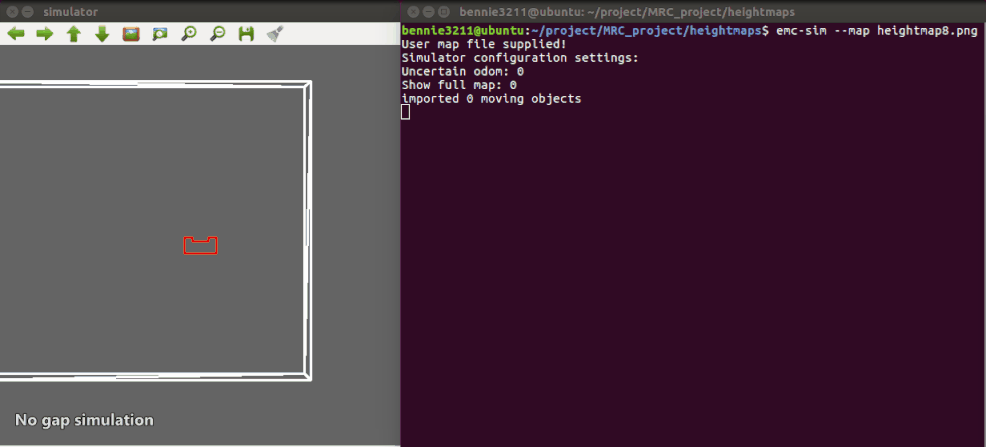Mobile Robot Control 2020 Group 1
Group Members
| Name | Student Number | |
|---|---|---|
| 1 | T.J.M. Snijders | 1017557 |
| 2 | B.P.J. Reijnen | 0988918 |
| 3 | J.H.B. de Zwart | 1020347 |
| 4 | S.C.M. Mennen | 1004332 |
| 5 | A.C.C.E. Vissers | 0914776 |
| 6 | B. Godschalk | 1265172 |
Introduction
This Wiki-page reports the progress made by Group 1 towards completion of the Escape Room Challenge and Hospital Challenge. The goal of the Escape Room Challenge is to escape a rectangular room as fast as possible without bumping into walls. The goal of the Hospital Challenge is to deliver medicines from one cabinet to another as fast as possible and without bumping into static and dynamic objects.
Logs
| Meeting | Date | Time | Chairman | Secretary | Summary | Download |
|---|---|---|---|---|---|---|
| 1 | 24-04-2020 | 15.00 | - | - | Introduction | |
| 2 | 28-04-2020 | 15.00 | - | T.J.M. Snijders | Introduction to tutor, discussed contents of Design Document | Notes |
| 3 | 01-05-2020 | 14.00 | B. Godschalk | S.C.M. Mennen | Discussed software architecture | Notes |
| 4 | 03-05-2020 | 14.00 | - | - | Discussed strategy for Escape Room Challenge | |
| 5 | 05-05-2020 | 14.00 | - | - | Discussed Escape Room Challenge software structure | |
| 6 | 08-05-2020 | 15.00 | S.C.M. Mennen | B.P.J. Reijnen | Notes | |
| 7 | 11-05-2020 | 14.00 | - | - | Decided that the current solution for the escape room challenge is sufficient |
Design document
In order to get a good overview of the assignment a design document was composed which can be found here. This document describes the requirements, the software architecture which consists of the functions, components and interfaces and at last the system specifications. This document provides a guideline to succesfully complete the assignment.
Escape Room Challenge
Strategy

To create a solid strategy a number of options has been outlined. Two solid versions at the end were considered; wall following and a gap scan version. After confirming that the gap scan version can, if correctly implemented, be a lot faster than following the wall on the left or right side of PICO. Since our goal was to finish the finish line first the decision has been made to create a gap scan. On the right the strategy flow has been mapped in a flow chart, which starts at 'Inactive' and ends at 'Move forwards' until the PICO (simulation) is stopped.
The first step that will be executed is the 'Initialize' step. This step will be used to clear and set all variable values to the default state from which it will continue to the '360° scan'. In this scan all Laser Range Finder measurements will be mapped into wall objects. When walls don't connect (like what happens in corners) a gap occurs which can be a possible exit or a faulty measurement.
The next step 'Gap?' is checking if the gaps found can be considered as a exit. If no gaps meet the specifications of a gap, the next step will be 'Move to better scan position' and will redo the previous steps. If the best gap meets the specifications the next step is 'Path planning' which will be executed to calculate the best way to the exit. When the path is set the following step will be 'Move to gap'.
The final step will 'Center?' which will center the robot in the corridor of the exit to prevent that incorrect alignment with the exit will result in a crash with the walls.
Parallel to this flow PICO will continuously keep track of objects with the laser range finder. Whenever a object is detected in a specific range of the robot a flag will be thrown. This flag can be used to update the path planning which will prevent crashes when the robot is heading in the wrong direction.
The simulation

With the created strategy in mind the first step was to find a way to detect the corridor of the exit in the Escape Room Challenge. A way to do this is by following the wall (on the left or right side of PICO) till PICO walks out of the Escape Room, but this can be a long and slow process, such that another strategy has been invented.
To differentiate walls and the exit a least squares regression line algorithm has been written. The Laser Range Finder (LRF) data points are fed into this algorithm and gives all the walls in the field of view (VOF) of the LRF. By connecting the walls together it can be possible that a gap occurs, which will be saved into the global reference frame. To collect the data the robot starts with a 360 degree VOF rotation, while doing so collecting all gaps. When the scan stops, all the collected gaps are checked based on some criteria to see if it is a door and if it is the best door possible and, if needed, fixed (straightened based on the adjacent walls). After founding the exit, the path planning calculates the needed angle and distance that needs to be driven to drive to the exit point. From there the robot rotates to the exit and starts moving towards the corridor connected to the exit (gap). When in between the walls, the robot starts to monitor the left and right wall to center itself between the walls of the corridor while moving towards the finish line. The invented strategy has been simulated in emc-sim and can be seen in the gif. The heightmap used for this simulation is shown below.


When the scan can not find any gaps in the walls, PICO will move 1 meter to the furthest point measured in the scan and performs a new scan. If, for any reason, PICO walks into a wall, the robot will move backwards and starts a new scan.
Escape Room Challenge results
Will be added after the challenge of 13-05-2020